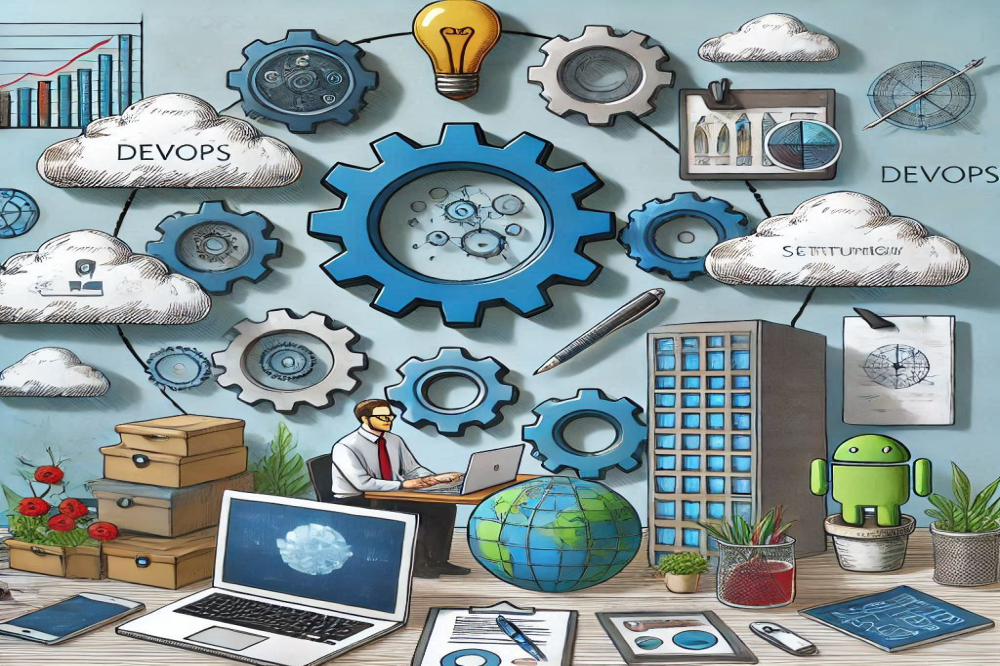
To truly grasp the role of DevOps in modern software development, let's start by understanding its origins. Imagine two islands separated by a turbulent sea – one island representing development teams, the other representing operations teams. Historically, these teams worked in isolation, leading to what we call the "wall of confusion." Developers would write code and throw it "over the wall" to operations, hoping it would work in production. This separation often resulted in delayed deployments, production issues, and finger-pointing when things went wrong.
DevOps emerged as a bridge between these islands, creating a cultural and technical revolution that transformed how we build, deploy, and maintain software. It's not just a set of practices or tools – it's a philosophy that emphasizes collaboration, automation, and continuous improvement.
The foundation of DevOps success lies in cultural transformation. Think of it as learning a new language – it requires more than just memorizing words; you need to understand the culture behind it. In DevOps, this means breaking down traditional silos and fostering an environment where:
Development and operations teams share responsibility for the entire software lifecycle, much like how a restaurant's success depends on both the chefs and the serving staff working in harmony. When something goes wrong, the focus is on learning and improvement rather than blame.
Teams communicate openly and frequently, sharing knowledge and perspectives. This might mean developers participating in operational planning, or operations staff providing input during the design phase. The goal is to create a shared understanding of both technical and business objectives.
Automation in DevOps is like building a sophisticated assembly line for software. Every manual, repetitive task automated reduces human error and increases efficiency. This includes:
Continuous Integration (CI) Imagine a quality control checkpoint that automatically inspects every piece of code as it's produced. CI systems automatically build, test, and validate code changes, providing immediate feedback to developers. This rapid feedback loop helps catch issues early when they're easier and less expensive to fix.
Continuous Delivery (CD) Think of CD as a well-oiled pipeline that can safely and reliably move code from development to production at any time. It automates the deployment process, ensuring consistency and reducing the risk of human error. This automation includes:
Modern DevOps practices incorporate sophisticated monitoring systems that act like the nervous system of your application. These systems provide real-time insights into:
Application Performance Just as a doctor monitors vital signs, DevOps teams track key metrics about application health and performance. This includes response times, error rates, and resource utilization.
User Behavior and Experience Understanding how users interact with your application is crucial. Modern monitoring tools provide insights into user journeys, feature usage, and potential pain points.
Infrastructure Health Monitoring extends to the underlying infrastructure, ensuring servers, networks, and other components are functioning optimally.
The DevOps lifecycle is continuous, like a never-ending wheel of improvement. Each phase flows into the next:
Plan and Code Teams collaborate on planning and development, using version control systems and collaborative tools. This phase emphasizes communication and shared understanding of objectives.
Build and Test Automated build processes compile code and run comprehensive test suites. This includes unit tests, integration tests, and security scans.
Deploy and Operate Automated deployment processes move code to production environments. Operations teams monitor and maintain the running systems.
Monitor and Optimize Continuous monitoring provides insights that feed back into the planning phase, completing the cycle.
Modern DevOps relies on a suite of tools and practices, each serving specific purposes:
Infrastructure as Code (IaC) Think of IaC as writing a detailed recipe for your infrastructure. Instead of manually configuring servers and services, you define them in code. This ensures consistency and makes infrastructure changes trackable and repeatable.
Version Control Version control systems act as the single source of truth for both code and infrastructure definitions. They track changes, facilitate collaboration, and maintain a historical record of the project's evolution.
Containerization Containers, like Docker, package applications and their dependencies into standardized units. This ensures consistency across different environments and simplifies deployment.
Success in DevOps isn't just about having the right tools or following certain practices. It's measured through key metrics that indicate improvement in both process efficiency and business outcomes:
Deployment Frequency How often can you safely deploy changes to production? Higher frequency usually indicates a more mature DevOps practice.
Lead Time for Changes How long does it take to go from code commit to production deployment? Shorter lead times suggest more efficient processes.
Mean Time to Recovery (MTTR) When something goes wrong, how quickly can you recover? Lower MTTR indicates better operational resilience.
Change Failure Rate What percentage of changes result in problems requiring remediation? Lower rates suggest more reliable processes.
As we look ahead, DevOps continues to evolve. New trends and practices are emerging:
DevSecOps Security is becoming increasingly integrated into the DevOps lifecycle, shifting left to catch vulnerabilities earlier in the development process.
AIOps Artificial Intelligence is being incorporated into operations, helping to predict and prevent problems before they occur.
Platform Engineering Teams are focusing on building internal platforms that make DevOps practices more accessible and standardized across organizations.
DevOps has fundamentally transformed how we approach software development and operations. It's not just about tools or automation – it's about creating a culture of collaboration, continuous improvement, and shared responsibility. As technology continues to evolve, the principles of DevOps remain crucial for organizations striving to deliver high-quality software efficiently and reliably.
The success of DevOps implementation depends on understanding that it's a journey, not a destination. Organizations must be prepared to continuously learn, adapt, and improve their practices as they mature in their DevOps journey. The key is to start small, focus on cultural change alongside technical implementation, and gradually build up to more sophisticated practices.